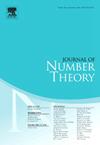拉马努金的10阶连分数作为模函数
IF 0.6
3区 数学
Q3 MATHEMATICS
引用次数: 0
摘要
研究了10阶连分数I(τ)、J(τ)、T1(τ)、T2(τ)和U(τ)=I(τ)/J(τ)的模性,它们是某些Ramanujan恒等式的特殊情况。连分数I(τ)和J(τ)是最近由Rajkhowa和Saikia引入的。我们证明了这些连分数可以用η商g(τ)来表示,它产生了同余子群Γ0(10)上所有模函数的域。因此,我们推导出g(τ)和U(τ)的模方程在任何水平上都存在,并推导出这些素数水平p≤11的方程。我们还证明了用g(τ)的奇异值可以显式地求出10阶的连分数,它在一定条件下产生虚二次域的Hilbert类域。我们采用李和朴的方法来确定我们的结果。本文章由计算机程序翻译,如有差异,请以英文原文为准。
Ramanujan's continued fractions of order 10 as modular functions
We explore the modularity of the continued fractions , and of order 10, which are special cases of certain identities of Ramanujan. The continued fractions and were recently introduced by Rajkhowa and Saikia. We show that these continued fractions can be expressed in terms of an η-quotient that generates the field of all modular functions on the congruence subgroup . Consequently, we deduce that the modular equations for and exist at any level and derive these equations of prime levels . We also show that the continued fractions of order 10 can be explicitly evaluated using a singular value of , which under certain conditions generates the Hilbert class field of an imaginary quadratic field. We employ the methods of Lee and Park to establish our results.
求助全文
通过发布文献求助,成功后即可免费获取论文全文。
去求助
来源期刊

Journal of Number Theory
数学-数学
CiteScore
1.30
自引率
14.30%
发文量
122
审稿时长
16 weeks
期刊介绍:
The Journal of Number Theory (JNT) features selected research articles that represent the broad spectrum of interest in contemporary number theory and allied areas. A valuable resource for mathematicians, the journal provides an international forum for the publication of original research in this field.
The Journal of Number Theory is encouraging submissions of quality, long articles where most or all of the technical details are included. The journal now considers and welcomes also papers in Computational Number Theory.
Starting in May 2019, JNT will have a new format with 3 sections:
JNT Prime targets (possibly very long with complete proofs) high impact papers. Articles published in this section will be granted 1 year promotional open access.
JNT General Section is for shorter papers. We particularly encourage submission from junior researchers. Every attempt will be made to expedite the review process for such submissions.
Computational JNT . This section aims to provide a forum to disseminate contributions which make significant use of computer calculations to derive novel number theoretic results. There will be an online repository where supplementary codes and data can be stored.
 求助内容:
求助内容: 应助结果提醒方式:
应助结果提醒方式:


